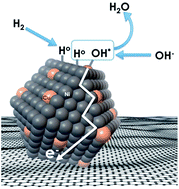当前位置:
X-MOL 学术
›
Sustain. Energy Fuels
›
论文详情
Our official English website, www.x-mol.net, welcomes your
feedback! (Note: you will need to create a separate account there.)
Nickel–copper supported on a carbon black hydrogen oxidation catalyst integrated into an anion-exchange membrane fuel cell
Sustainable Energy & Fuels ( IF 5.0 ) Pub Date : 2018-07-20 , DOI: 10.1039/c8se00261d Aaron Roy 1, 2, 3, 4, 5 , Morteza R. Talarposhti 1, 2, 3, 4, 5 , Stanley J. Normile 5, 6, 7, 8 , Iryna V. Zenyuk 5, 6, 7, 8 , Vincent De Andrade 5, 9, 10, 11 , Kateryna Artyushkova 1, 2, 3, 4, 5 , Alexey Serov 1, 2, 3, 4, 5 , Plamen Atanassov 1, 2, 3, 4, 5
Sustainable Energy & Fuels ( IF 5.0 ) Pub Date : 2018-07-20 , DOI: 10.1039/c8se00261d Aaron Roy 1, 2, 3, 4, 5 , Morteza R. Talarposhti 1, 2, 3, 4, 5 , Stanley J. Normile 5, 6, 7, 8 , Iryna V. Zenyuk 5, 6, 7, 8 , Vincent De Andrade 5, 9, 10, 11 , Kateryna Artyushkova 1, 2, 3, 4, 5 , Alexey Serov 1, 2, 3, 4, 5 , Plamen Atanassov 1, 2, 3, 4, 5
Affiliation

|
This work introduces the first practical platinum group metal-free (PGM-free) electrocatalyst for the hydrogen oxidation reaction (HOR) in alkaline membrane fuel cells (AMFCs), based on nickel-rich Ni95Cu5-alloy nanoparticles supported on Ketjenblack (KB) family carbon blacks. The catalyst synthesis is scalable and results in an expected true alloy of NiCu, which is thoroughly characterized by XRD, microscopy and XPS. The reactivity of the catalyst towards the HOR is studied by cyclic voltammetry and explained in view of its composition and structure. This catalyst showed the highest specific activity compared to previously reported NiCu electrocatalysts and was successfully integrated into an AMFC membrane electrode assembly (MEA) using a commercially available state-of-the-art membrane and an ionomer. Single MEA fuel cell tests have demonstrated a power density of 350 mW cm−2 at 80 °C, which sets a technical record for a PGM-free anode in realistic operating conditions. The MEA with the NiCu/KB anode catalyst layer was evaluated by in situ nano- and in operando micro-X-ray computed tomography (CT) and the results suggest that the nickel state in NiCu is hydrophobic in nature, where the NiCu surface may be isostructural with β-Ni(OH)2. The hydrophobic nature of the electrocatalyst allows for improved water distribution in the MEA and overall fuel cell as observed by in operando micro-X-ray CT.
中文翻译:

镍-铜负载在集成到阴离子交换膜燃料电池中的炭黑氢氧化催化剂上
这项工作介绍了第一种实用的基于富镍Ni 95 Cu 5的碱性膜燃料电池(AMFC)中的氢氧化反应(HOR)的无铂族金属(无PGM)电催化剂。Ketjenblack(KB)族炭黑上负载的铝合金纳米颗粒。催化剂的合成具有可扩展性,可产生预期的真实NiCu合金,并通过XRD,显微镜和XPS对其进行了全面表征。通过循环伏安法研究了催化剂对HOR的反应性,并就其组成和结构进行了解释。与以前报道的NiCu电催化剂相比,该催化剂显示出最高的比活性,并使用市售的最新型膜和离聚物成功地整合到AMFC膜电极组件(MEA)中。单个MEA燃料电池测试表明功率密度为350 mW cm -2在80°C的温度下,这创造了在实际操作条件下无PGM阳极的技术记录。通过原位纳米和操作显微X射线计算机断层扫描(CT)对具有NiCu / KB阳极催化剂层的MEA进行了评估,结果表明,NiCu中的镍态本质上是疏水的,其中NiCu表面可能是疏水的。与β-Ni(OH)2同构。如在操作微X射线CT中所观察到的,电催化剂的疏水性质允许改善在MEA和整个燃料电池中的水分布。
更新日期:2018-09-25
中文翻译:

镍-铜负载在集成到阴离子交换膜燃料电池中的炭黑氢氧化催化剂上
这项工作介绍了第一种实用的基于富镍Ni 95 Cu 5的碱性膜燃料电池(AMFC)中的氢氧化反应(HOR)的无铂族金属(无PGM)电催化剂。Ketjenblack(KB)族炭黑上负载的铝合金纳米颗粒。催化剂的合成具有可扩展性,可产生预期的真实NiCu合金,并通过XRD,显微镜和XPS对其进行了全面表征。通过循环伏安法研究了催化剂对HOR的反应性,并就其组成和结构进行了解释。与以前报道的NiCu电催化剂相比,该催化剂显示出最高的比活性,并使用市售的最新型膜和离聚物成功地整合到AMFC膜电极组件(MEA)中。单个MEA燃料电池测试表明功率密度为350 mW cm -2在80°C的温度下,这创造了在实际操作条件下无PGM阳极的技术记录。通过原位纳米和操作显微X射线计算机断层扫描(CT)对具有NiCu / KB阳极催化剂层的MEA进行了评估,结果表明,NiCu中的镍态本质上是疏水的,其中NiCu表面可能是疏水的。与β-Ni(OH)2同构。如在操作微X射线CT中所观察到的,电催化剂的疏水性质允许改善在MEA和整个燃料电池中的水分布。











































 京公网安备 11010802027423号
京公网安备 11010802027423号